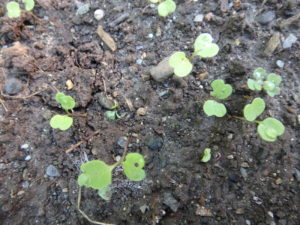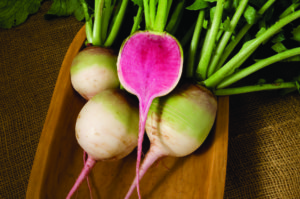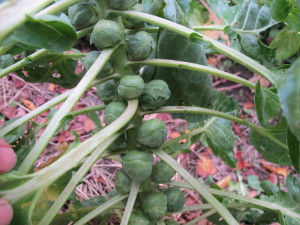Veggies You Can Plant Now for Fall Eating
Most gardeners don’t think of July as the time to plant seeds in the vegetable garden. But it should be. This is a good time to plant many things including broccoli, Happy Rich, lettuce, kohlrabi, fall radishes, carrots and beets. With good warmth and plenty or rain (or water from your hose), these plants will probably do better now than in if they were planted in the spring.
If you planted peas, spinach or lettuce early this spring, you probably have a bed that is empty now. Instead of just growing weeds, why not get out your seed packets and plant a second crop in that bed?
In the spring I generally plant seeds in those little black plastic 6-packs. I do that because the soil outdoors is cold and wet, and seeds are prone to rot. Now, however, the soil is warm and seeds will germinate much more quickly. All you have to do is check them daily to be sure that the soil has not dried out.
Broccoli, if you read the seed package, takes about 55 days to maturity. So if you plant in mid-July, you should be picking heads of broccoli in mid-September or even a bit earlier. Read the seed packets carefully: as I peruse my Johnny’s Selected Seeds catalog, I see broccoli varieties that mature in anywhere from 48 to 80 days. Some varieties like ‘Arcadia’ (63 days) are listed as “Tolerant of cold stress.” That one also says it makes lots of side shoots. Since broccoli produces well into October for me, getting side shoots is important.
So how should you plant broccoli if you have always put it in as nice little plants that you – or the local grower down the road – has grown? I would suggest planting 3 seeds in groups about 16 inches apart. Why 3 seeds? First, not every seed will germinate, so I like to ensure that at least one will come up. But rather than plant them like carrots in a long line, just plant a few seeds where you want one plant. Then as soon as the plants have 2 real leaves, pull out all but one. And since you’ll see leaves in clumps every 16 inches, you won’t have a hard time identifying them – even if you have never done it before.
One of my favorite veggies is one you might not know: Happy Rich. It is a non-heading broccoli type plant. Instead of one big head, it produces many small heads similar to side-shoots on standard broccoli. I get seeds from Johnny’s Seeds. A similar plant is piricicaba, which I get from Hudson Valley Seed Library. Both are quick to mature and have sweet flavored florets. I find they are tasty even if the florets don’t get picked on time and they produce white or yellow flowers. And the leaves are tasty, too!
Carrots and beets can take 55 days to maturity, or up to 80 days. Select early varieties for fall crops now. Yaya and Mokum are both under 60 days, while most storage carrots are about 75 days – which still means they will be ready by the end of September – and long before hard frost.
I suggest buying pelleted seeds for carrots if planting now. Pelleted seeds are coated with a layer of clay, which means they are much larger and easier to handle. Plant them an inch or two apart and they will not be competing with each other as tiny seedlings – and will grow faster. Planted an inch apart you will not have to thin them until they are edible-sized.
I planted lettuce and arugula seeds in late June. Arugula, which is basically a weed, germinated right away. Both need little or no soil cover – they need light to germinate. I try to plant lettuce once a month all summer and into the fall to keep it coming. Hot weather encourages lettuce to bolt, or produce flowers and seeds. Once the plants start to elongate in preparation for flowering, they get a bit bitter. Edible, but not as sweet.
Swiss chard is another quick and easy crop that you can plant now. My High Mowing organic seed catalog has half a dozen different varieties that mature in 50 to 60 days, and produce baby greens in 25. I particularly like the ‘Rainbow Mix’ that has stems of yellow, red and orange. And did you know that beets and Swiss chards are just variations on the same species? Yup. And you can eat the roots of Swiss chard like beets when you pull them in the fall.
My favorite radish is one that I will plant soon: ‘Red Meat’ radish from Johnny’s seeds. It is red in the middle instead of white like a watermelon. It never has the sharp bite of a spring radish, and stays nice even when the radishes get to be golf ball-sized and bigger. If planted in spring, it bolts.
In the past I’ve had good luck planting daikon radishes in the summer for fall use, too. These Japanese radishes get huge, and have a distinctive bite. Many use them for pickling.
So get out there and plant some seeds. Just be sure that they stay well-watered and most things will do just fine. Even many green beans only need 55 days. So if you were too busy to plant before the 4th of July, get started now.
Read Henry’s twice-weekly blog posts at https://dailyuv.com/
Cold Weather Crops
At this time of year I eat one of the “three B’s” from my garden every day: broccoli, Brussels sprouts or kale. All right, don’t get on my case. I know kale doesn’t start with a “B”. But it’s a brassica, the family that contains those other two, plus cabbage, rutabagas, cauliflower, kohlrabi and more. All are good cold weather crops.
In addition to surviving frosts, all the brassicas are healthy foods with lots of Vitamin C, soluble fiber and compounds thought to prevent cancer (though that is a little controversial). What you may not know is that boiling brassicas removes most of those cancer-fighting compounds, but steaming them or cooking them in a microwave dos not. Three to four minutes of steaming will cook your brassica nicely, but not steal many nutrients. But the best way to eat them is raw.
There are many varieties of broccoli, almost all are excellent. Arcadia is one that has done well for me, and is very cold hardy. I talked to my friend Chaz Meyers of Cornish Flat, N.H., who I think of as Mr. Broccoli. He and his wife, Jill Johnson, grow about 50 plants every year, freezing it and eating it all year. He told me that ‘Packman’ is favorite, in part because it produces lots of side shoots. He also likes ‘Waltham’ and ‘Gotham’ varieties.
Chaz recommends cutting the primary head of broccoli on an angle so that the stem, which is often a bit hollow, does not hold water (which might promote rot). He also suggests, if the summer is dry, watering your broccoli well after cutting the big head. That keeps the plant healthy and promotes the development of side shoots.
I once planted a little vegetable garden for a woman who didn’t know much about gardening. I planted two broccoli plants that produced magnificent heads in July. She ate them, with glee, and then pulled out the plants. Yikes! I regretfully explained that the most productive part of the plant are all those little “side shoots” that come after the main head. That, like the Energizer Bunny, broccoli keeps on producing for months. I’m still eating side shoots from plants I put in back in June.
Although broccoli are known for having little green caterpillars on them, mine have not had any this year – or none that I’ve seen. Maybe I’ve eaten a few. The best solution to the green caterpillar problem is just to soak the broccoli in cold water with a little salt in it before cooking. They will float up.
I dare say that my Brussels sprouts are perfect right now. Each is the diameter of a quarter- or a half dollar – and unbothered by any pests or diseases. I eat some every night for dinner: a dozen is just the right sized serving for me, so my six plant will keep me eating them for weeks. Brassicas are very hold hardy, and Brussels sprouts and kale will survive temperatures down to 20 degrees – or even colder. Frost helps to sweeten up their flavors.
Deer don’t bother my garden until it gets cold. Then they look for my Brussels sprouts and kale and broccoli. Once they waited until the night of December 24 to eat my Brussels sprouts, though that might have been the reindeer, waiting while Santa was inside the house. I recently took some preventive measures. I covered my kale with a scrap of chicken wire that I just draped over my plants, and then I surrounded the Brussels sprouts with some four-foot chicken wire. The broccoli will have to fend for itself – I’ve run out of fencing.
Kale is the perfect vegetable to freeze. Unlike spinach, it doesn’t get soggy when frozen. It keeps its character. I blanch it for a minute in boiling water. That kills the aging enzymes that would make it turn old and woody after just a few months in the freezer. When I take it out, I drop it into a sink full of cold water, spin it dry in my salad spinner, pat it dry with a tea towel, and put it in freezer bags. I suck out the air in the bags with a drinking straw. The straw goes into a zipper bag that is 99% closed, and I suck out the air. I snap the bag shut as I pull out the straw, and it’s ready to go in the freezer.
I know people that are gaga about kale chips, dried kale that is salty and crispy, the health-nut food to substitute for potato chips. I recently tried making my own but I’m neutral about them. Here’s what I did: I stripped the leaves off the central stem, and tore the leaves into pieces and put them in a big bowl. I coated them with a garlic and olive oil solution (I used 3 cloves garlic and a few tablespoons of oil). I sprinkled pepper flakes or nutritional yeast on the leaves and tossed some more. I added salt, but not a lot.
Then I put some kale chips in the oven at 150 degrees for 2 hours with the convection fan blowing, others in a food dehydrator at 135 degrees for 2.5 hrs. Maybe I needed to use more salt or oil, but I was aiming for a health food. And this tasted like something a little too healthy. Oh well. They’re crispy, but they’re definitely not as good as potato chips. Darn!
Eating the brassicas from my garden at this time of year is a wonderful way to transition to winter. I have food in the freezer from the summer, and root crops stored in the cellar. But it feels great to walk to the garden with a knife and cut something fresh for dinner.
Henry Homeyer is a gardening educator, speaker and writer. Reach him at henry.homeyer@comcast.net.






